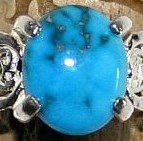
Commercial Turquoise Mining At The Godber Mine
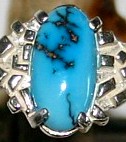
 |
Commercial Turquoise Mining At The Godber Mine |
 |
Interested in commercial turquoise mining operations in Nevada? This is my page of information on The Godber Mine......
For many
years, the US had a historical tradition of small-scale mining. Individuals or small
groups of miners would spend part of the year working the higher-grade sections of old
mines and ship the high-grade ore to be processed at smelters or other facilities. Those individual prospectors that made a
valuable find could make a decent living off their claims - or at least a nice supplement
their other income. In the 1940s and 1950s, that tradition began to die out and only a few
hardy souls remain that work their claims on a small scale and make a living off them. In the last 60 years, roadblocks of
environmental regulations and permits, together with the high costs of capitalization have
made commercial small-scale mining extremely difficult. However, there are still a few
operators that continue persevere against the trend and actively work their mines on a
small-scale basis. Fine examples of present day
small-scale miners are the husband and wife team of Bruce and Jeri Woods. They are
actively mining the Godber turquoise mine in Lander County, Nevada on a part time basis.
The Godber mine, which has also
been known as the Dry Creek or Burnham mine is located north of Highway 50,
about 30 miles east of Austin, in central Nevada. The mine is famous for very hard, high
quality deep blue turquoise with a dark colored spider web type matrix. The Woods have
been working their mine for the last 6 years and have uncovered a good quantity of that
very fine high quality turquoise – the type the mine has been famous for producing.
To market their turquoise, the Woods have an ebay store, sell some finished jewelry from
the Godber mine at their web site, and Bruce’s Uncle sells some Godber gems at his
turquoise jewelry shop in Austin. Compared to metal mining, there are
some advantages for small mining operations that specialize in mining gemstones: there is
little competition from big companies because of the “labor intensive” nature of
gemstone mining, these is a growing demand for all “American” gemstones, there
is no need to process the ore with toxic chemicals or ship large tonnages to be processed.
Some gems can recovered with simple gravity processes, others are harvested by sight of
the gem across a screen or conveyor. Just as there are advantages, there are also some
disadvantages in mining gemstones: the miner has to put far more effort into marketing the
mine product, and the gems often have their highest value only after cutting, or even
making into finished jewelry. |
|
|
Turquoise has been
gaining in popularity in recent years, and good quality Nevada turquoise is in demand.
American material generally brings a higher price than equivalent turquoise from other
countries. The better grades of turquoise are those which are strong and hard enough that
they do not require any special stabilization or strengthening treatment be fore they can
be used in jewelry. Most of the turquoise from the Godber mine falls into this category
and is considered as being a natural gem grade. Prices for better grades of Nevada
turquoise rough typically ranges in price from $600 to $2500 per pound. Cut stones of
natural Nevada material can sell from $2.00 to $25.00 per carat with much of the Godber
turquoise coming in more at the top of that scale because of its high quality. In some
rare cases, turquoise can fetch even higher prices that those just mentioned, but that
range is more typical. The price for the finished gems depend a lot on quality of the
material with the hardness, color, matrix patterns, location of origin and quantity being
purchased. For a number of reasons, all of the current turquoise mining operations here in
the US are done on a small scale. The demand for high quality American turquoise is far
greater than the existing small mines can supply, and because the U.S. mines do not
produce enough gem material to meet the country's market demands, turquoise from other
parts of the world, particularly China, is often used by Native Americans and other
jewelry artists to make their jewelry. |
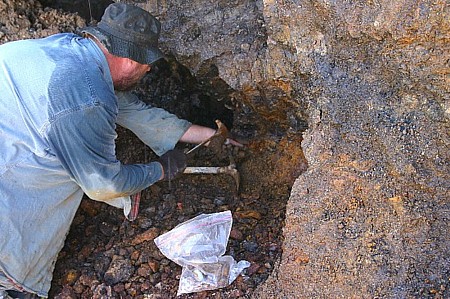 |
|
Bruce and Jeri purchased the Godber claim in 1999, though they had
been involved with other turquoise properties for years before. Both Bruce and Jeri work
full time at the Round Mountain gold mine in northern Nye County, about 80 miles south of
the Godber Mine. So whether they are mining for gold at Round Mountain, or for Turquoise
at the Godber on their days off, they spend a lot of their time mining. Bruce works as an
equipment operator at Round Mountain and is on rotating schedule that allows him a week
off once a month. Much of that time he spends out at the Godber where he operates a dozer
and track mounted front end loader to work the mine. Bruce and Jeri both grew up in
Austin, the unofficial turquoise capital of Nevada, and Bruce’s family has been
involved in turquoise mining for many years. Bruce has actually been mining turquoise off
and on since he was a teenager. In
addition to working with Bruce on mining the Godber, Jeri also does the environmental
permitting for the mine, which in these days is as important as the mining itself. It has
not been a simple effort, but they have been able to comply with the requirements of 43
CFR 3809, the BLM rule governing the surface management of mining operations. One does not
yet have to be a lawyer to obtain permits, but you do have to have a good understanding of
the rules and Jeri had to put in her time to read and learn the rules. The mine is located
on BLM land, and the BLM office which oversees the permitting of their mining operations
is located at Battle Mountain. Jeri has met with the BLM staff and she and Bruce maintain
good, cooperative working relationship with them. With input from the BLM, Jeri developed
the “Plan of Operations” that is now required by the BLM rules even for small
operations like theirs. The Woods have had to post reclamation bonds to cover any surface
disturbances they create in their operations. The reclamation bonds are required to
guarantee that the surrounding area will be reclaimed to an acceptable state when the
mining operation is finished. The amount required for the bond is proportional to the
amount of area
to be disturbed. Since
their big dozer can tear up a lot of ground in a hurry, with the costs of bonding and
reclamation, Bruce and Jeri have to be careful not to disturb any more area than they
really need to. The whole environmental permitting
process can become so complicated and costly (with no guarantee of return) that
comparatively few people in the US are mining for turquoise with heavy equipment today.
The heavy equipment itself, of course, is also very expensive to purchase, operate and
maintain. For miners like the Woods, who continue to work a small mining operation, it is
in many ways a labor of love. They really enjoy the beauty of the turquoise they produce.
So far, it has not really been much of a scheme for making big money. |
||
The first mining at
what is now known as the Godber property was in 1932, when Bob Burton and Joe Potts
discovered turquoise on a hill southwest of the Dry Creek Ranch and filed the “Last
Chance” claim. After some initial work, they sold out to Frank Burnham who worked it
extensively with surface pits and what was basically a coyote hole type of underground
working, following seams with good turquoise wherever they led. Burnham was said to have
taken out $100,000 worth of turquoise in the short period he owned the mine. Burnham sold
out to the Godber family in 1934, and the Godbers held the mine until the mid 1990s. Under
the ownership of the Godbers, considerable underground work was done through a crosscut
adit into the hill. The work mining turquoise was continued until it reached a depth of
about 100 feet below the surface. In the last years the property was held by the Godbers,
Clyde Wright and his family operated it under a lease agreement. One of the interesting
things that Mr. Wright did with the property was to wash and screen the old Godber
underground mine dumps. He was able to recover a significant amount of material simply by
washing the old underground mine dump, which presents an interesting future possibility
for the many other old dumps around the property. A succession of owners then held the
property for a short time, after which it was acquired by the Woods in 1999. It is still
held as an unpatented mining claim. |
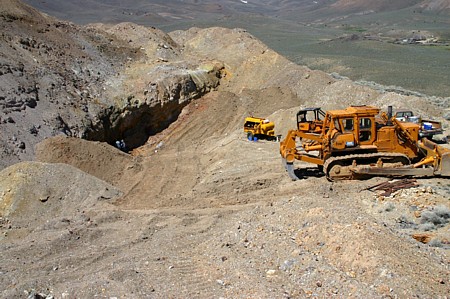 |
|
| Turquoise
mining is a risky proposition, as one never knows when a clay seam yielding good turquoise
will simply pinch down and disappear. The clay seam may well open up and re-appear in a
few inches, maybe in a few feet, or maybe never. Turquoise deposits, with a few
exceptions, are not large and some fairly productive mines may yield well for only a few
months or years after which the deposits may become depleted, as the vein may pinch out or
a series of pockets may be exhausted. Even where the deposit persists, the high wall or
bank may become so large and steep that it is no longer cost effective to continue surface
mining. The mine owner must then search the property for additional deposits. When using
the dozer to lay back a high wall face or open new parts of the mine up for further work,
lots of money may be expended with little or no return. If additional turquoise is not
found quickly, years may pass while the mine lies unworked. If a new owner then buys or
leases the claim and reactivates the workings, there is no guarantee that the new work
will be successful. For Bruce, his dozer
consumes roughly 100 gallons of diesel per day, which can really add up in cost,
especially if he is working in barren rock. While Bruce uses his dozer to move large amounts of barren rock out of the way, things are different when he is actually mining the turquoise, and extracting the gem rock is a hand labor intensive process. He uses a moil – a jack hammer like compressed air tool to peel away the barren parts of the rock to expose the turquoise bearing clay seams. The clay seams themselves are dug with a screwdriver so the turquoise itself is not damaged during the extraction process. Although he does use explosives at times – Bruce tries to minimize their use as the explosives can induce fractures into the turquoise and cause it to be unusable. Most of the Godber turquoise is found in nugget form – a boytryoidal aggregate that grows to become one piece of turquoise – known as a “nugget”. These nuggets are often the best material at the mine, and they are most commonly found in seams of clay. When they come out of the ground, they are covered with the clay in which they grew – red, gold or even black, and they do not always show clearly the turquoise within. Bruce’s experience at the Godber has allowed him to develop an uncanny ability to recognize the turquoise nuggets by shape, even when they are fully coated in mud and their beautiful blue color is not exposed. |
||
| The day I was out at the Godber mine with the Woods, Bruce had used the dozer to expose some of the old underground workings dug by the Godber family many decades before. He and Jeri were following some of the clay seams in the rock looking for turquoise nuggets. Bruce was finding some smaller ones, but as he continued chip away into the face of the workings finding a few small pieces here and there – the rock changed and things began to improve greatly. Bruce hit a pocket of large nuggets (around golf ball size) of dark turquoise with a very tight spider web pattern. This is very valuable turquoise and is among the best of the best. The pocket was a good one and it was a productive day. These operations do not produce vast quantities of turquoise - a very good day of mining at the Godber may produce a few pounds of the highest grade of turquoise, on a poor day the production may be perhaps only a small handful of lower grade rock – or even less. Even though the Woods have some lapidary equipment for cutting stones, they have most of their turquoise cut for them. They sell little or no turquoise as rough, since the profit margin is so much higher for the cut stones. |
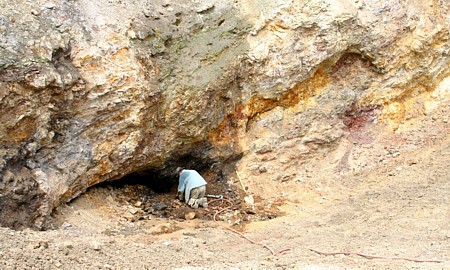 |
|
Nevada turquoise mining has always been done as a small scale operation, because the labor intensive and time consuming process of extracting turquoise from its mother rock just does not lend itself well to large scale operations. Unlike modern gold mining, where a comparative few employees can mine and process thousands of tons of rock each day, turquoise mining requires a "hands on" approach with a pick or hammer and chisel – a very labor intensive process. Gem material must be slowly and carefully removed from its mother rock or it will be destroyed in the extraction process. This is the major reason the gem quality turquoise deposits of Nevada are not worked more extensively - because the cost of labor in the US is expensive. As a result, it is no accident that most of the world's turquoise supply now comes from China where manual labor costs are very low. High turquoise prices and strong demand are required to justify the expense of working a turquoise mine in the US on a true "full time" commercial basis. One advantage modern miners have over the "old time"
prospectors, who worked with hand tools, is larger equipment like backhoes and bulldozers,
which allow barren overburden to be easily removed. Even so, initiating a larger-scale
mining operation for turquoise today requires an immense amount of capital and the
expenses of purchasing equipment and other essential items can severely tax the
resources of a small mine operator. The Woods have made a very significant investment in
time and money to put the Godber into production. |
|
|
| Turquoise is a secondary mineral, meaning that it is
formed by the effect of water and weathering on existing rocks. Formation of turquoise
requires five conditions: the presence of three chemicals:1) Copper, 2) Aluminum, and 3)
Phosphate. It also requires two environmental conditions - 4) Voids in the rock for the
turquoise to form in, and 5) An arid environment. This is just because of the way
turquoise forms - too much running water simply washes away the solutions that could form
the turquoise. To have all these conditions occur in the same place is a bit unusual.
While the Godber mine produces
some of Nevada’s finest turquoise, this unusual combination of geologic conditions
has come together to form good quality turquoise at a number of places in Nevada. Regional thrust faulting in
Nevada has caused widespread folding and fracturing of the local rocks, which has resulted
the formation of the necessary voids. By a lucky coincidence, it just turns out that many
of the sedimentary rocks which were broken in this process just happened to be high in
Aluminum and Phosphate. The mountain building processes which caused the faulting and
fracturing, also introduced widespread low grade copper mineralization. Together with
Nevada's generally arid environment and sufficient amounts of time, these conditions have
led to the formation of world-class turquoise deposits in Nevada. The mountain building
processes have also caused silicification (the introduction of silica or quartz into the
rock), which hardens the turquoise and is why such a high percentage of Nevada turquoise
is of a true gem quality. However, in places those same geologic systems that caused the
formation of turquoise, also introduced gold mineralization into the same types of rocks.
Other types of mineral deposits such as barite were created as well. This leads to a
situation where it is fairly common to find gold deposits in or around the general
neighborhood of turquoise mines in Nevada. This is why many old Nevada turquoise
properties have been acquired and explored by various gold mining companies. The formation of these unusual gold deposits have been a huge economic boon to the state of Nevada, but it also has unfortunately led to a number of turquoise properties being mined out as gold mines or potential turquoise properties otherwise being tied up by gold mining companies. Barite mining operations have also led to the destruction of several previously productive turquoise properties. The net result of this situation is that it further limits the amount of high quality Nevada turquoise available in the US. At the Godber mine, turquoise occurs in weathered,
argilized shales associated with clay seams, folds in the sedimentary rocks and zones of
unaltered rocks that form a blockage to any downward moving solutions. Turquoise occurs at
several places on the mine property. Nearly all of the turquoise occurs as boytryoidal
“nuggets”, but a small part also occurs as veinlets filing cracks in the rock.
Compared to most other mines, a much higher percentage of the turquoise produced is hard
and of a deep blue color. Younger volcanic rocks also crop out in the area of the mine. Bruce says it will take more than his
lifetime to completely work out the Godber – so he figures to be at it for a long
time to come. Although there are far fewer small miners out working the hills than there
used to be, as long as the Woods have anything to say about it, there will still be active
small scale mining right here in the USA. |
||
Want to know a little bit more about this crazy prospector guy? Well, here's a little bit more about me, and how I got into prospecting: Chris' Prospecting Story Interested in seeing more gold? Here are some interesting photos of beautiful Gold Nuggets